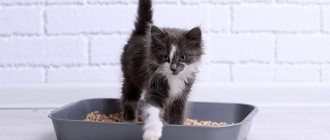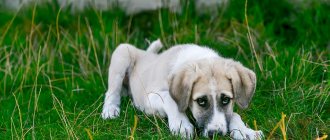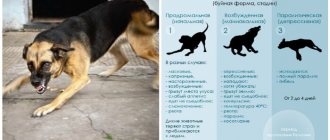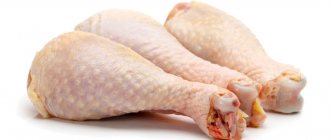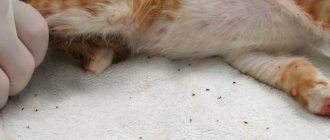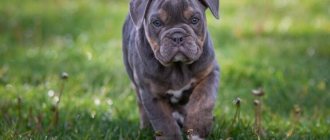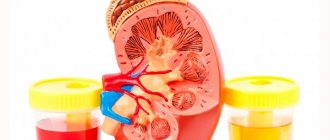Causes
Excessive straining during bowel movements is the main cause of rectal prolapse. Rectal prolapse in cats is caused by the following pathologies:
- Constipation. Feeding kittens predisposed to megacolon with economy-class dry food can cause stool retention and severe straining.
- Excessive worminess.
- Pathological birth.
- Diseases of the genitourinary area. Mostly older cats are susceptible.
- Anal wounds.
- Tumors.
Kitten has rectal prolapse
Causes of intestinal prolapse in cats
There are many reasons that lead to rectal prolapse. Some of them can only be diagnosed by a veterinarian after examining the animal. Most often, rectal prolapse is associated with gastrointestinal problems.
There are several reasons why rectal prolapse occurs:
- Frequent constipation. The animal strongly strains its muscles during defecation, which leads to disruption of their tone. In addition, too hard feces injure the intestinal walls, its walls become inflamed.
- Diarrhea. Severe diarrhea leads to intestinal inflammation. Frequent bowel movements lead to decreased muscle tone.
- Poor nutrition. There are two diet options: feeding with natural and industrial feed. Animals that eat prepared foods are more prone to rectal prolapse. There may be two reasons: - low quality feed, which leads to disruption of the gastrointestinal tract; - lack of fluid in the pet’s diet, which causes the stool to become too hard.
- Infection with worms. Parasitic infestation is most dangerous for young animals, because their immunity is not yet fully developed. Worms release their metabolic products into the host's body. This leads to intoxication of the body. The gastrointestinal tract becomes inflamed and ceases to function normally.
- Disruption of the reproductive system. In cats, prostatitis or prostate adenoma can lead to rectal prolapse. Inflammation of the reproductive system leads to disruption of the intestines. In cats, rectal prolapse often occurs during difficult births.
- Chronic diseases of the intestinal tract (proctitis, colitis). Inflammation of the intestines leads to weakening of the muscle tone of the anus.
- Neoplasms in the intestines and the presence of foreign bodies in the preanal area.
- Injuries. One bad fall from a kitten can lead to rectal prolapse.
- Injuries and neoplasms in the spinal cord.
- Cystitis. If your cat urinates frequently, he will also tense his anus in the process. Muscle tone decreases and the intestines become inflamed.
You may be interested in: Eye inflammation in a cat: symptoms and treatment of conjunctivitis
Most often, this problem occurs in kittens up to six months old, as well as in old animals that are more than ten years old. A predisposition to rectal prolapse is not inherited.
Symptoms
An observant fellinologist is able to detect pathology at an early stage of its occurrence based on the following signs:
- Difficulty defecating. The cat makes noise, grunts, meows.
- When examining the anus, one finds a protruding tube or a protruding pinkish lump during bowel movements.
- The cat licks its anus frequently.
- In severe cases, a prolapsed intestine is observed, changing its color from pink to bluish-purple. The cat bites the itchy surface and rubs against the floor or walls.
- The animal moves with difficulty and breathes heavily.
Cat licks anus
recommended articles:
- Smecta for cats with diarrhea
- Why are cats overweight?
Symptoms of pathology in cats
The main sign of rectal prolapse is the appearance of anxiety in your pet. Anxiety in a cat is especially clearly manifested before a bowel movement or immediately after it. A characteristic sign is increased attention to the area under the tail. The pet licks the anal area, tries to relieve the itching, making attempts to scratch the anus on hard surfaces - riding on the “butt”.
A symptom of disorders in the rectal area is the appearance of blood from the anus. Depending on the degree of development of the pathology, the manifestation of symptoms will vary. In the first stages, the rectal area protrudes only during the act of defecation.
With the onset of the second stage of the pathological process, the prolapsed part of the appendix does not reduce on its own after defecation. In this regard, the prolapsed intestine can only be reset manually.
The third stage of rectal prolapse is characterized by the appearance of any attempt by the animal to tense the abdominal muscles. The last, fourth stage, is characterized by intestinal prolapse even when the pet is simply walking. It is important to show your pet to a specialist in the first stages, since the cause of specific symptoms can be pathologies such as hemorrhoids, rectal hernia, anal fissures. A qualified specialist can make an accurate diagnosis. Diagnosis of pathology is carried out using a visual examination, laboratory and instrumental studies. An ultrasound examination of organs located in the abdominal cavity and a general clinical blood test are prescribed.
Based on the data obtained, the specialist develops further treatment tactics. Therapy can be conservative or surgical.
Pathogenesis
Strong attempts lead to an increase in pressure inside the intestine. A segment of the rectal area is pushed out through the anus and everted. One part of the alimentary tube is wrapped inside the other. The fragment that ends up on the outside pinches the sphincter. The mucous membrane dries out, cracks, and swells. Increasing pain causes the orbicularis muscle to contract more strongly. Blood flow stops, mucosal cells die, intestinal microflora begins to multiply, consuming organic debris. Increasing pain causes reflex breathing disorder. If help is not provided, the cat dies not from sepsis, but from painful shock.
Diagnostics
I distinguish the following types of intestinal prolapse in cats:
- Rectal prolapse.
- Prolapse of the small intestine.
Differential diagnosis is a test with a medical thermometer. A device lubricated with Vaseline is inserted into the affected tube, trying to straighten it. If the intestine is easily reduced, small intestinal prolapse is diagnosed. Pathology can be eliminated exclusively by surgery. When the thermometer encounters an obstacle, it is believed that the rectum, which has thicker walls, has prolapsed. There is hope for healing through simple methods.
Neglected case
Additional studies make it possible to determine the disease that led to excessive straining and prolapse of the end section of the alimentary canal. Fecal analysis determines the presence of intestinal parasites; x-rays or ultrasound can detect pelvic narrowness, adhesions, and foot formations.
First aid
The owner of the cat calls a veterinarian to the house, and before his arrival, cleans the pathological segment from contamination, protects it from drying out, lubricating it with ichthyol ointment or petroleum jelly. Apply a bandage to prevent re-clogging, as well as to prevent the proliferation of secondary microflora. If you managed to avoid severe drying out and necrosis of the prolapsed area, the prognosis is good, the cat can be completely healed.
Initial phase of the disease
Helping a cat with rectal prolapse and treatment at home
With such rectal prolapse, emergency veterinary assistance is needed.
Timely provision of assistance plays a very important role in the treatment of the disease. Doing without qualified help is very problematic.
First aid before the doctor arrives is cleansing of dirt, lubricating the prolapsed segment with Vaseline oil or ichthyol ointment. Applying a protective bandage to avoid re-contamination and proliferation of pathogens.
If the release occurred relatively recently, and the tissue did not have time to become severely weathered and dead, the prognosis for treatment can be considered favorable.
Help consists of setting the fallen fragment back inside and applying a purse-string suture around the anus.
Suture
A suture is applied to prevent re-loss. The seam must be free so that the animal can empty itself without problems. The stitches are removed after forty-eight hours. If the attempt at reduction ends in the release of a larger fragment than it was before, prompt assistance is necessary.
In case of tissue necrosis, cracks, tears, or wounds, surgical amputation of the damaged part is used.
The healthy part should be sutured to the edges of the anus. It is extremely important to see a doctor on time, otherwise there is a risk of secondary infectious pathologies, which is fraught with serious consequences. In the advanced stage of the disease, uncontrolled bowel movements are observed.
Postoperative period
The postoperative period requires special attention from the owner.
Inspection of the blanket in the postoperative period.
It is necessary to ensure that the animal does not pull off the fixing bandage or diaper, limit licking the sore area, and scratching. Drug treatment is indicated in the form of mild laxatives.
To avoid infection - antibiotics, anti-inflammatory drugs . When diagnosing other causes of the disease - specialized therapy . Pain-relieving rectal gels are prescribed for lighter stools.
Diet
In the postoperative period, a diet . It is recommended that adult cats be given infant formula containing dietary fiber, which will prevent constipation and reduce the risk of relapse. If the kittens are still fed their mother's milk, formula can also be used. If not, light low-fat meat is acceptable.
Treatment
Treatment methods vary depending on the phase of the disease. If the prolapse is detected in a timely manner and there is no necrotization of the walls of the prolapsed tube, it is set back and secured with a purse-string suture around the anus. In this case, it is necessary to ensure that the lumen of the rectum is not narrowed and defecation occurs unhindered. Sutures are removed 2 days after application.
In case of severe drying of the prolapsed segment or the presence of dead textures, emergency surgery is performed. The necrotic part of the intestine is removed, and healthy tissue is sewn to the edges of the anus. If, after an attempt at reduction, a larger fragment falls out again, the pathological area is examined and removed.
They put a diaper on a cat
Postoperative period
The rehabilitation period requires increased attention and care. A diaper is put on the cat to prevent it from licking or scratching the healing itchy area. Drug treatment, in the absence of complications, consists of preventing constipation. The cat is given mild laxatives orally, and pain-relieving suppositories or gels rectally.
For the prevention and treatment of constipation during the rehabilitation period, prebiotics are indicated - preparations containing Lactulose. This disaccharide is inaccessible to the body's enzyme systems and vulgar intestinal microflora. And beneficial bacteria feed on Lactulose, multiply, inhibit putrefactive microbes and normalize digestion. The following drugs are in demand:
- Lactusan.
- Duphalac.
Your veterinarian may prescribe petroleum jelly as a laxative.
If the temperature rises and your health worsens, antimicrobial and anti-inflammatory drugs are used.
A kitten's prolapsed intestine was set
Diet
The rehabilitation period is associated with diet therapy. The cat needs gentle food that contains all the components and does not irritate the operated surfaces. To prevent stool retention, food containing dietary fiber is necessary. Specialized baby food has these properties.
An older kitten is gradually introduced to low-fat meat products. It is allowed to use ready-made food, initially wet. If the cat owner prefers dry food, select premium products.
Problems with intestinal prolapse in a 3 month old kitten
Kitten Slavik
471 views
July 20, 2020
Slavik. Today, July 15, he already has his 5th operation. And of these five, this is the second cavity. ((His rectum prolapses. Every time he goes to the toilet in a big way. The first time he was operated on in Veles - they closed the hole. (1080 rubles) - it fell out again the next day. They put it back in Corgi and tightened it threads (200 rubles) It fell out after a few days(((They set it again (400 rubles) It fell out again. Then I set it myself((((. They said if it continues to fall out, we will do abdominal surgery((((... It fell out. They did it abdominal surgery (RUB 1,500) The next day it fell out again: (((((((. We sewed up the hole (RUB 500).. It fell out after a couple of days. Then we had the hole completely sutured (RUB 500) Completely. For a couple of days everything was fine. We even went to the toilet a couple of times normally (he pushes and pushes into a tiny hole...). But this morning I saw what is in the photograph ((((((The intestine fell out about 15(!) cm. As Zhuikov later said , not only the rectum, but also the large intestine fell out. The reason for the prolapse is very weak ligaments that hold the intestines together and increased peristalsis. At first, the cause of increased peristalsis was explained by loose stools. We managed this. Antibiotics, Metrogyl, special medical nutrition (Proplan gastrointestinal). In addition to surgical interventions, we have therapy - droppers with ringer twice a day, cefazolin, metrogil, dexamethosone - IV, no-spa IM, enterosgel. Now everything is, ttt, normal. The stool returned to normal. But the problem did not go away((((... At the same time, the kitten feels relatively normal, has a good appetite, is affectionate. What is Slavik’s problem - what actually happened the last time when the rectum and colon prolapsed? Weak ligaments holding the intestines , they just tore from the efforts.. They were just sewn on during the last operation. Now we are holding our fists so that everything grows together and they don’t tear anymore... But that’s not so bad. The bad thing is that, for an unknown reason, he has very the intestinal mucosa is inflamed, in particular the large intestine. Partly due to these constant prolapses. And this is already fraught with very bad consequences. The fact is that the large intestine is (hereinafter quoted) “the lower part of the digestive tract, namely the lower part of the intestine, in which water is mainly absorbed and formed feces are formed from food gruel." And if the mucous membrane is not in order, the water is simply simply not absorbed. Even if you drink it, it will not enter the body. If inflammation also affects the small intestine, then this threatens the fact that not only water, but also nutrients will no longer be absorbed (the bulk of them are absorbed in the small intestine) ... - as a result, hunger, dehydration, and ... . Therefore, it is now very important for us to restore intestinal health. Please advise what to do
Age:
3
Chronic diseases:
Slavik. Today, July 15, he already has his 5th operation. And of these five, this is the second cavity. ((His rectum prolapses. Every time he goes to the toilet in a big way. The first time he was operated on in Veles - they closed the hole. (1080 rubles) - prolapsed again
The question is closed
intestines
guts
abdominal surgery
Treatment of associated symptoms
If a kitten is diagnosed with worms, it is necessary to carry out deworming, but only in the case when the animal’s health becomes satisfactory. Use medications based on age: medications intended for adults can cause poisoning in a kitten.
For genitourinary diseases in older animals, the symptoms of the underlying pathology are eliminated.
For pathological births, a caesarean section is indicated. If the paraanal glands often become inflamed, they are cleaned, and if an abscess occurs, surgical treatment is performed.
If a cat has tumors in the anus, chemotherapy or surgical removal of the tumor is used.
Prevention of rectal prolapse
Preventive measures are aimed at preventing the causes of the disease.
Animals should not be fed exclusively dry food and solid food. The diet should be balanced and include porridge, fermented milk products: kefir, cottage cheese, sour cream.
It is necessary to periodically deworm the animal and undergo a comprehensive examination in the clinic, including examining feces for the presence of helminthic infestation. A prerequisite is to keep pets clean, adhering to all sanitary and hygienic standards.
Do not neglect the periodic treatment of the cat’s house, bedding, and the pet’s habitat.
Do not allow free access to the trash can, household chemicals, and detergents.


